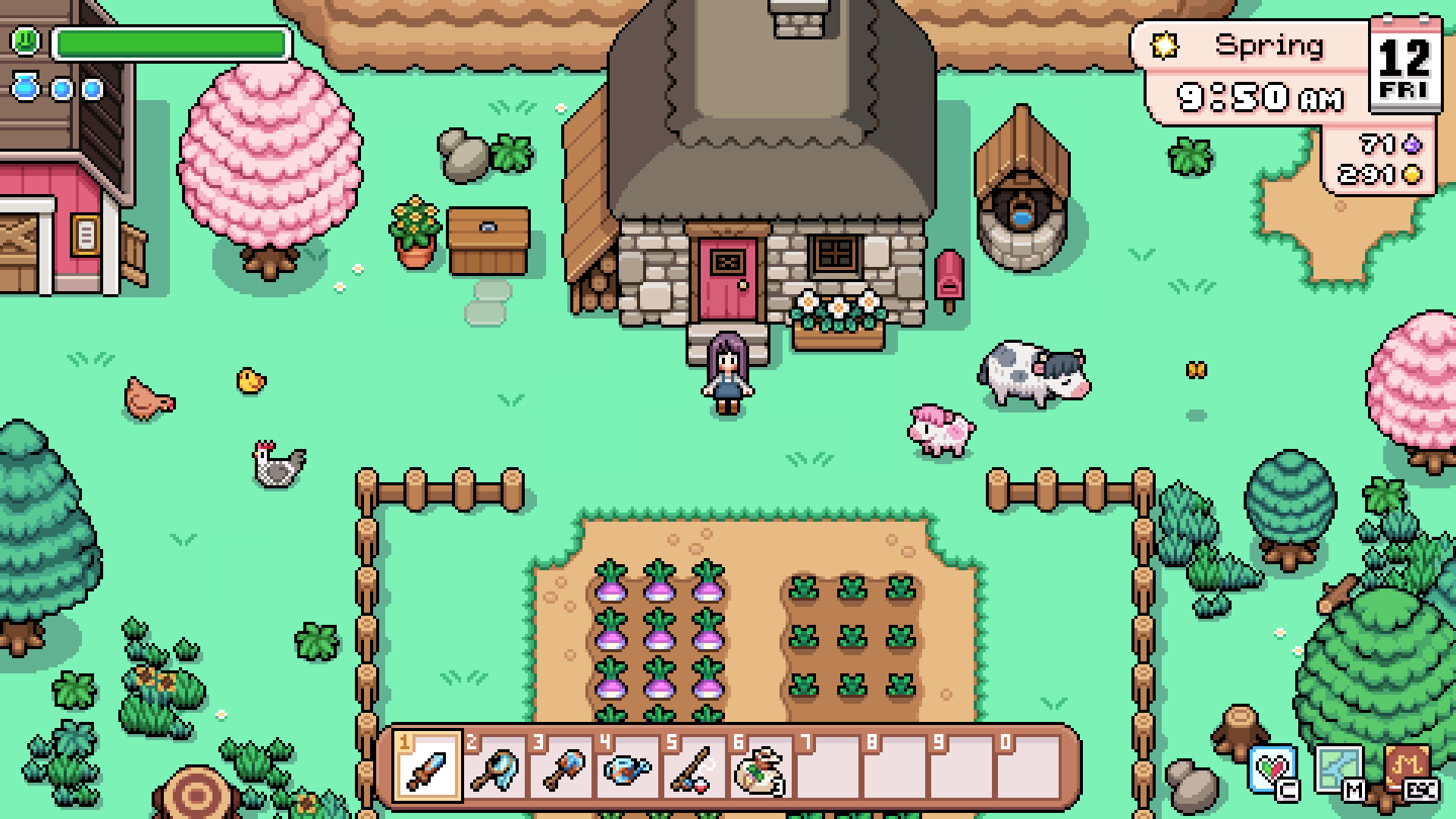
Bridges collapsed, buildings crumbled — the sleepy town of Mistria must rebuild. You can see the earthquake’s devastation in Mistria’s sidewalks and buildings too worn to enter. But you can also see its beauty — something that’s evident not only in its lush spring flowers and berry-laden bushes, but in its people, too. Around the edges of destruction, the people of Mistria continue on with life. A group gathers weekly to play “Dungeons & Drama” (remind you of anything?); Celine, all blond hair and braids, tends to flowers in her garden bed; March, a grumpy young blacksmith, forges swords and shovels at his shop; Reina, a quiet, masterful cook, preps stews at the inn; and the ever-optimistic Adeline acts as the town’s mayor. To put it simply, Mistria is alive — its buzz radiates from its town core, spreads into its wilderness, and seeps down into its mines.
Fields of Mistria, the first game from Chicago-based NPC Studio, begins like many farming simulators do: A wayward adventurer moves to town with little but a hardworking spirit, into a neglected cabin on a patch of land that’s primed for farming. Adeline offers the player character this old farm in exchange for some help rebuilding Mistria after the earthquake. From the first swing of your ax, Fields of Mistria is sending a message — this is a game about community. It’s not necessarily a revelatory idea for games of this genre: In Animal Crossing: New Horizons, you’re building up an island locale; in Story of Seasons or Harvest Moon, you’re integrating yourself into a world; and in Stardew Valley, you’re restoring a community center. Fields of Mistria’s foundation is built upon the legacy of these games and others, but it’s the community — the non-playable characters who are so grateful for your help — that sets the game alight.

You’ll see the DNA of Fields of Mistria’s inspirations in the day-to-day of the game. Wake up on the farm, then get to work. What exactly you do next is up to you. Are you heading straight into the mines to seek out monsters and mineral ores? Or you would rather get out your watering can and start planting vegetable seeds? Forage for flowers and berries? Buy a fishing pole and cast out into the river? Or are you heading to the inn to meet your new neighbors? Eventually, regardless of your way of life, the Mistrian townspeople will start to ask you for help, be it with bringing your flora and fauna discoveries to the museum or collecting resources to rebuild a bridge, mill, or sidewalks. And so you do. Between your own chores, you chop down trees and put your pickax to stone, using both your sweat equity and real money to build Mistria back up.
I’ve found it easy to settle into the rhythm of Fields of Mistria’s days. But it’s the moments between these chores that make the game feel like something special. Fields of Mistria’s characters make the game buzz with life — while you’re going on with your day, they’re going on with theirs. I can visit Celine in her garden, tending to her violets and daisies. I show bugs to a group of children playing at the beach. I linger at the Sleeping Dragon Inn’s bar while residents role-play among themselves at the table nearby. It helps that these interactions — whether it’s conversations that include me or not — are so well written, the characters so developed. I want to know what Juniper is talking about, to hear March sass local himbo Olric. I look forward to Fields of Mistria’s Friday nights, when everyone gets a little bit silly at the bar. Mistria also has a mystery tied to a dragon statue that keeps watch over my farm, so I like to visit him each day, too.
I’ve often struggled against the disease of optimization in video games, especially in games like these, but Fields of Mistria’s characters seem to be the antidote, a reason to pull myself away from carefully scheduled days full of checklists. There are other ways that Fields of Mistria eases me away from the grind. Like in Stardew Valley, you will collect things from the land, like vegetables and bugs, but the only real benefit is a few items, currency, and the joy of completion. If I miss a sea creature tied to summer, I don’t feel like I’m being punished — I’m happy to do other things as I wait for summer to return. Requests from residents have no time limits, so I can complete them here or there in quiet moments. Stores are always open, so there’s no need to plan out my days around that. When you drop an item on the ground — you’ll do that a lot, because you can’t carry that much in Fields of Mistria — it’ll stay there indefinitely, so you can come back to get it later. There’s no real punishment for passing out in the mines or running out of energy, either. Make nice with Mistria’s dragon and you’ll unlock magic, some spells of which are very handy on the farm. There are so many little quality-of-life improvements that Fields of Mistria has implemented to take some of the stress out of the genre. (That said, it’s not entirely stress-free; Fields of Mistria’s days are quite short, which has been a frustration at times.) Each season, I’ve delighted in seeing the changes among the world, be it the new berries dotting the shrubs or the seasonal outfits for each of the residents.

NPC Studio said on its Steam page that Fields of Mistria, despite being in early access, has about 30 to 40 hours of gameplay. I’ve played more than 20 hours so far, and I’ve just made it into my first winter. I’ve reached the current end of the mines (60 levels), built out barns for my chickens and cows, and filled the museum up with fish, flowers, and berries. Even then, there’s no shortage of things to do as more of the world opens up: For instance, I’m building up to bringing more animals into Mistria, like capybaras, rabbits, sheep, ducks, horses, and alpacas. For an early access game, Fields of Mistria is shockingly large. NPC Studio said on its website that it expects the game to stay in early access for about a year, with regular updates planned along the way.
Simply put, Fields of Mistria is magic — and it’s not even done yet.
Fields of Mistria was released Aug. 5 on Windows PC. The game was reviewed on Steam Deck using a download code provided by NPC Studio. Vox Media has affiliate partnerships. These do not influence editorial content, though Vox Media may earn commissions for products purchased via affiliate links. You can find additional information about Polygon’s ethics policy here.
Source:https://www.polygon.com/review/444036/fields-of-mistria-review-pc-early-access






